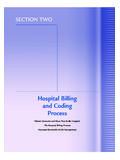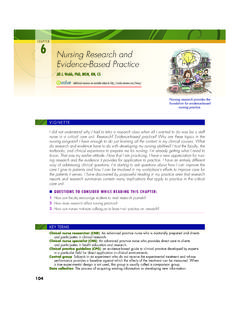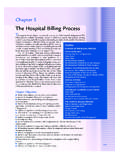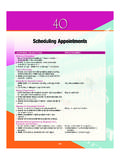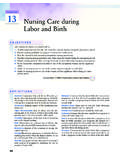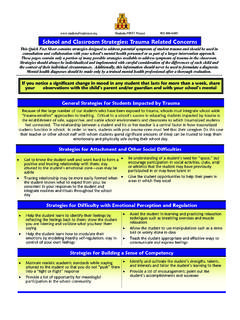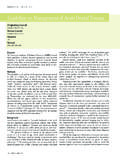Transcription of CHAPTER 4 Kinematics of Trauma - …
1 Kinematics of TraumaCHAPTER 4 Define energy in the context of production of injury. Describe the association between the laws of motion, energy, and the Kinematics of Trauma . Describe the relationship of injury and energy exchange to speed. Discuss energy exchange and the production of cavitation. Given the description of a motor vehicle crash, use Kinematics to predict the likely injury pattern for an unrestrained occupant. Associate the principles of energy exchange with the pathophysiology of injury to the head, spine, thorax, abdomen, and extremities resulting from that exchange. Describe the specific injuries and their causes as related to interior and exterior vehicle damage. Describe the function of restraint systems for vehicle occupants.
2 Relate the laws of motion and energy to mechanisms other than motor vehicle crashes ( blasts, falls). Describe the five phases of blast injury and the injuries produced in each phase. Describe the differences in the production of injury with low-, medium-, and high-energy weapons. Discuss the relationship of the frontal surface of an impacting object to energy exchange and injury production. Integrate principles of the Kinematics of Trauma into patient assessment. Describe the recommended card and procedure for documenting TCCC care on the the completion of this CHAPTER , the reader will be able to do the following: CHAPTER 437/20/10 10:16:26 AM7/20/10 10:16:26 AM44 PREHOSPITAL Trauma LIFE SUPPORTYou and your partner are dispatched to a two-car collision.
3 The day is warm and sunny. The scene is secured by law enforcement when you arrival, you confirm that there are only two cars involved. The first car is in the ditch on the right side of the road and has impacted a tree at the passenger-side door. There are bullet holes in the left-front door. At least three holes are visible to you. There are two occupants in the other car veered off the left side of the road and hit a utility pole, centered between the two headlights. There are two people in that car. It is an old vehicle without air bags. There is a bent steering wheel, and, there is a bull s-eye fracture of the windshield on the driver s side. As you look into the car on the passenger side, you find an indentation in the lower part of the passenger-side dash.
4 None of the passengers in either vehicle are wearing a safety belt. You are dealing with four injured patients two in each car and all have remained in the are the senior EMT-paramedic on the scene. It is your responsibility to assess the patients and assign priority for transportation. Take the patients one at a time and describe them based on the would you describe each patient based upon the Kinematics ?What injuries do you expect to find?Unexpected traumatic injuries are responsible for more than 169,000 deaths in the United States each collisions accounted for more than 37,000 deaths and more than 4 million injured persons in problem is not limited to the United States; other coun-tries have an equal frequency of vehicular Trauma , although the vehicles may be different.
5 Penetrating Trauma from guns is very high in the United States. In 2006, there were almost 31,000 deaths from fi rearms. Of these, over 13,000 were In 2008, there were over 78,000 nonfatal fi rearm injuries Blast injuries are a major cause of injuries in many countries, whereas penetrating injuries from knives are prominent in others. Successful management of Trauma patients depends on identifi cation of injuries or potential injuries and the use of good assessment skills. It is frequently diffi cult to determine the exact injury produced, but under-standing the potential for injury and the potential for signifi -cant blood loss will allow the critical-thinking process of the provider to recognize this likelihood and make appropriate triage, management, and transportation management of any patient begins (after initial resus-citation) with the history of the patient s injury.
6 In Trauma , the history is the story of the impact and the energy exchange that resulted from this impact. 4An understanding of the energy exchange process will lead to the suspicion of 95% of the potential the provider, at any level of care, does not under-stand the principles of Kinematics or the mechanisms involved, injuries may be missed. An understanding of these principles will increase the level of suspicion based on the pattern of injuries likely associated with the survey of the scene on arrival. This information and the suspected injuries can be used to properly assess the patient on the scene and can be transmitted to the physicians and nurses in the emer-gency department (ED).
7 At the scene and en route, these sus-pected injuries can be managed to provide the most appropri-ate patient care and do no further harm. Injuries that are not obvious but are still severe can be fatal if they are not managed at the scene and en route to the Trauma center or appropriate hospital. Knowing where to look and how to assess for injuries is as important as knowing what to do after fi nding injuries. A complete, accurate history of a traumatic incident and proper interpretation of this data will provide such information. Most of a patient s injuries can be predicted by a proper survey of the scene, even before examin-ing the CHAPTER discusses the general principles and mechani-cal principles involved in the Kinematics of Trauma , and the sections on the regional effects of blunt and penetrating Trauma address local injury pathophysiology.
8 The general principles are the laws of physics that govern energy exchange and the general effects of the energy exchange. Mechanical principles address the interaction of the human body with the compo-nents of the crash for blunt Trauma ( motor vehicles, three- and two-wheeled vehicles, and falls), penetrating Trauma , and blasts. A crash is the energy exchange that occurs when an object with energy, usually something solid, impacts the human body. It is not only the collision of a motor vehicle, but also the crash of a falling body onto the pavement, the impact of a bullet on the external and internal tissues of the body, and 447/20/10 10:16:30 AM7/20/10 10:16:30 AMCHAPTER 4 Kinematics of Trauma 45the overpressure and debris of a blast.
9 All of these involve energy exchange, all result in injury, all involve potentially life-threatening conditions, and all require the correct man-agement by a knowledgeable and insightful prehospital care PrinciplesA traumatic event is divided into three phases: precrash, crash, and postcrash. Again, the term crash does not neces-sarily mean a vehicular crash. The crash of a vehicle into a pedestrian, a missile (bullet) into the abdomen, and a con-struction worker striking the asphalt after a fall are all exam-ples of a crash. In each case, energy is exchanged between a moving object and the tissue of the human body or between the moving human body and a stationary precrash phase includes all of the events that pre-ceded the incident.
10 Conditions that are present before the incident, but important in the management of the patient s injuries, are assessed as part of the precrash history. These include such things as a patient s acute or pre-existing medi-cal conditions (and medications to treat those conditions), ingestion of recreational substances (illegal and prescription drugs, alcohol, etc.), and a patient s state of mind. Typically, young Trauma patients do not have chronic illnesses. With older patients, however, medical conditions that are present before the Trauma event can cause serious complications in the prehospital assessment and management of the patient and can signifi cantly infl uence the outcome. For example, the elderly driver of a vehicle that has struck a utility pole may have chest pain indicative of a myocardial infarction (heart attack).
